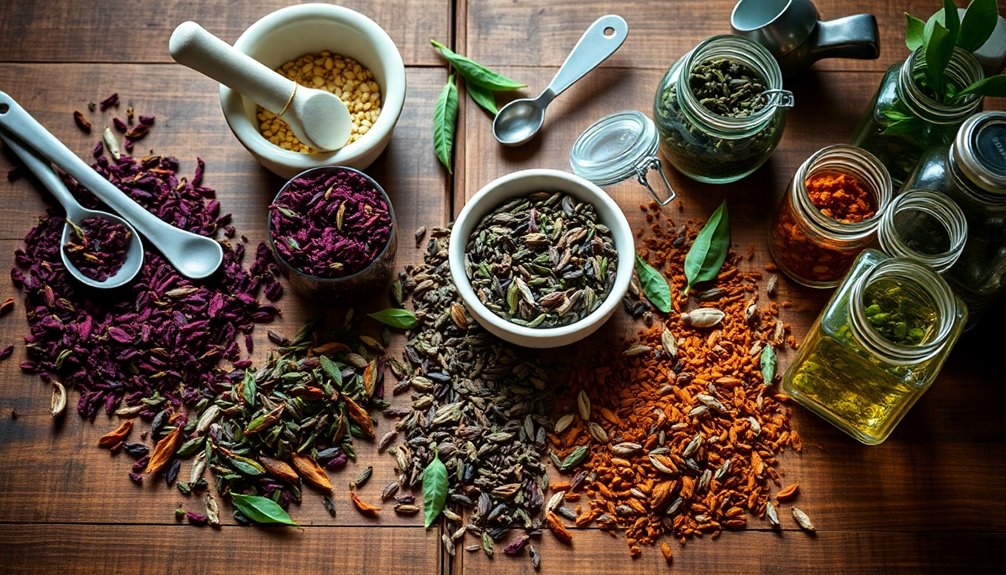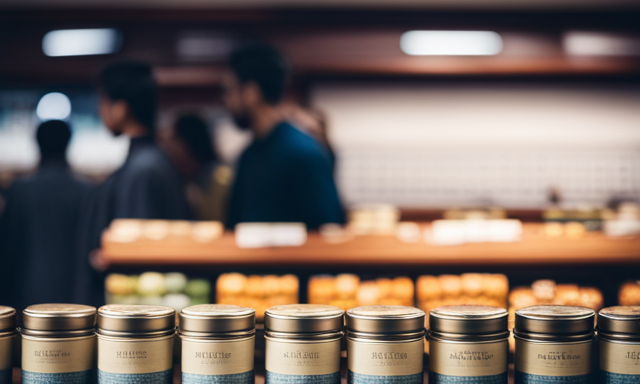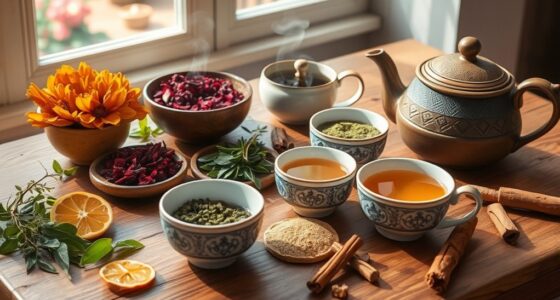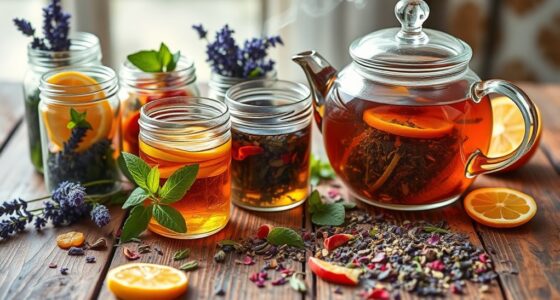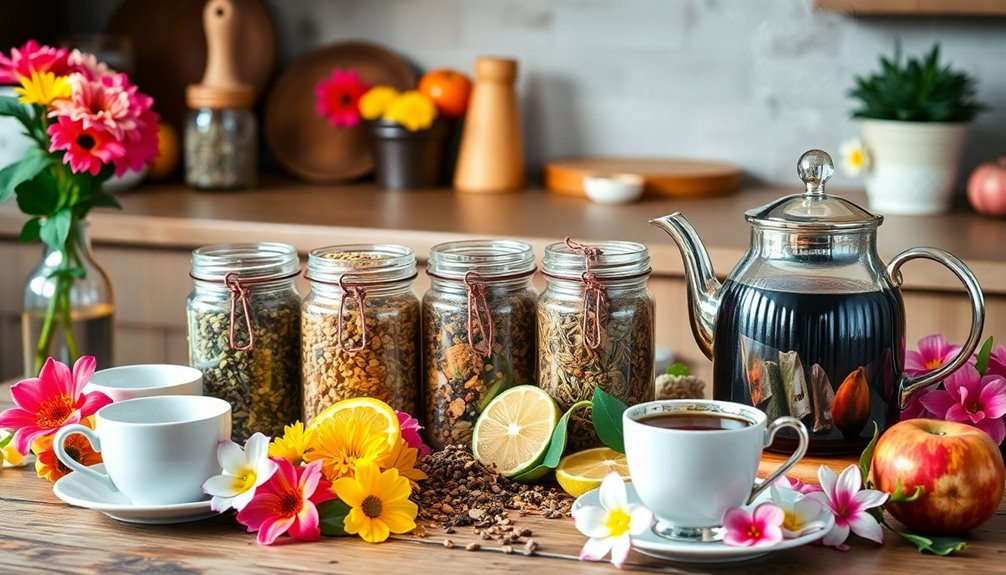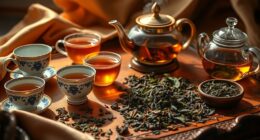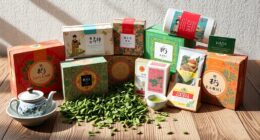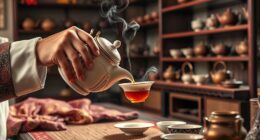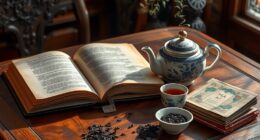To perfect your tea blending skills, you'll need some fun and helpful tools! Start with a scale to measure your ingredients accurately. An infuser is great for steeping your blends just right, while storage containers keep everything fresh. Don't forget a thermometer to get the water temperature perfect! Adding a tea grinder can help with fresh herbs and spices, too. Keeping your workspace clean and organized makes blending easy and enjoyable. Finally, joining online tea communities offers extra tips and inspiration. Get ready for a delightful tea journey where you can learn more about creating magical blends!
Key Takeaways
- A precision scale ensures accurate measurement of ingredients for consistent tea blends.
- Quality infusers allow for optimal steeping of various tea types, enhancing flavor extraction.
- A thermometer helps maintain the ideal water temperature for different tea varieties.
- Storage containers keep ingredients fresh and organized, preventing contamination and loss of flavor.
- Joining online tea communities provides inspiration, tips, and access to blending resources.
Introduction
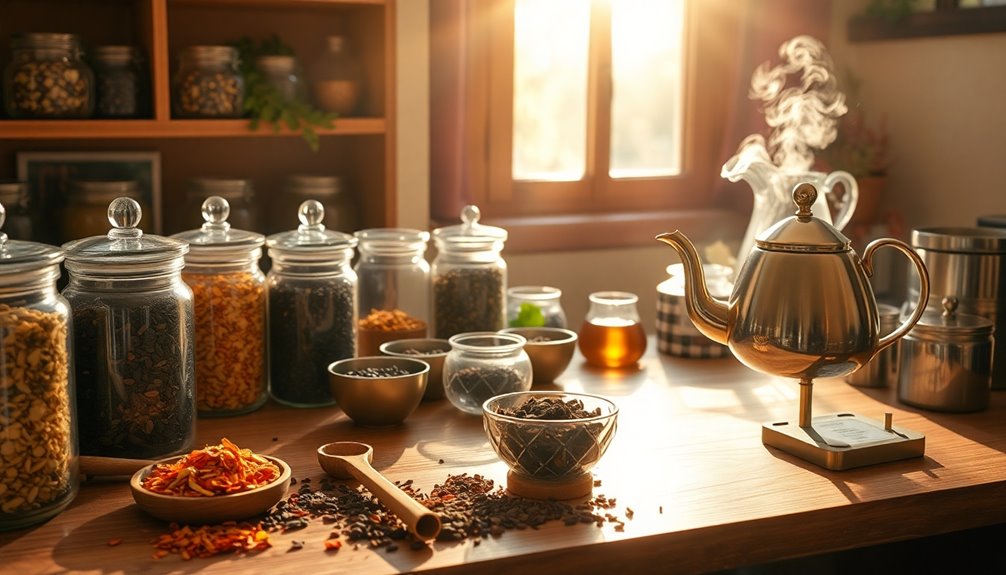
Tea blending is an art that combines creativity with knowledge, and mastering it can enhance your tea-drinking experience. As you dive into the world of tea blending, you'll discover how fun and rewarding it's to create your own unique blends.
With a Tea Journey Starter Set, you can explore different flavors, aromas, and health benefits of various ingredients, including herbal blends and essential oils. Additionally, understanding the health benefits of certain ingredients can elevate your blends even further. Herbal teas like chamomile and peppermint can add unique flavors while providing health benefits such as relaxation and digestive support. Furthermore, incorporating ingredients with anti-inflammatory properties can enhance your overall wellness. Different tea types can also contribute distinct caffeine levels to your blends, affecting both flavor and energy.
Here are some essential tools to help you get started:
- Measuring spoons: These ensure you get the right proportions for your blends.
- Airtight containers: These keep your tea fresh and flavorful.
- Mixing bowl: This is where the magic happens as you combine your ingredients.
Don't forget to keep records of your successful blends! Jot down the ratios and combinations you love, so you can recreate those delightful flavors again and again. Additionally, consider incorporating ingredients like turmeric and ginger into your blends, as they possess anti-inflammatory properties that can enhance your tea's health benefits.
Engaging with tea communities can inspire you and give you tips as you explore your personal tea journey. So, grab your tools and let your creativity flow—there's a whole world of delicious blends waiting for you!
Herbal Ingredients Enhance Flavor

When it comes to enhancing your tea blends, herbal ingredients play a crucial role in transforming ordinary flavors into extraordinary experiences.
Imagine sipping a cup of tea that not only warms you up but also delights your taste buds! You can achieve this by adding herbal ingredients like chamomile, peppermint, and hibiscus. Each of these adds unique taste notes and lovely aromas that complement your base tea. Peppermint oil can also provide a refreshing twist to your blend while promoting easier breathing. Additionally, incorporating essential oils for relaxation can enhance the soothing experience of your tea. Herbal teas like chamomile are known for their anti-inflammatory properties, which can further enrich your blend. The use of traditional tea ceremony methods can also inspire your blending techniques.
Here are some tips for blending teas with herbs:
- Use Dried Herbs: They're convenient and last longer, making them perfect for your blending adventures.
- Know Your Flavor Profile: Some herbs, like Echinacea, can boost your immune system, while tulsi helps you relax.
- Balance is Key: When blending, try using 3 parts base herbs, 1-2 parts supporting herbs, and a sprinkle of accent ingredients. Additionally, consider incorporating essential oils like lavender for added relaxation benefits.
Ingredient Ratios Matter Greatly
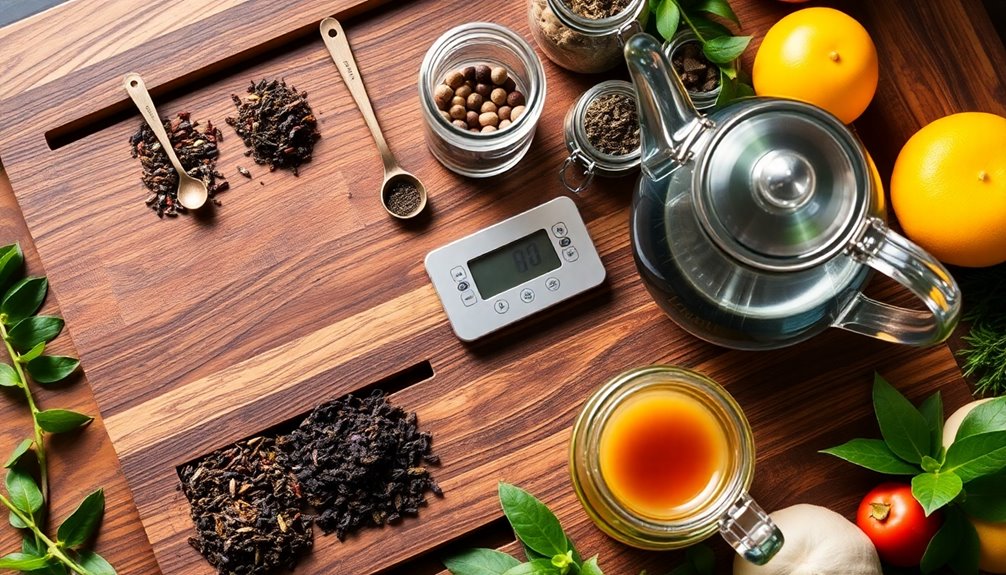
Getting the ingredient ratios right is essential for creating a harmonious tea blend. When you're blending your favorite teas, think of a simple guideline: use 3 parts base ingredients, 1-2 parts supporting ingredients, and 1/4-1 part accent ingredients. This helps create a balanced flavor profile that everyone will enjoy!
For lighter teas, like white tea, you'll need less flavoring—just a drop of essential oil for every 2 ounces. Heavier teas, such as black tea, can handle a drop for every 4 ounces.
When crafting an herbal blend, try to stick to five dried herbs or flowers at most. This keeps your blend focused and prevents overpowering flavors.
Understanding the strength of each ingredient is crucial. Strong flavors can easily take over, so measure carefully!
And don't forget to document your ingredient ratios. This way, you can replicate your successful blends again and again, ensuring every cup brings the same joy.
Cultural Significance of Tea Blends
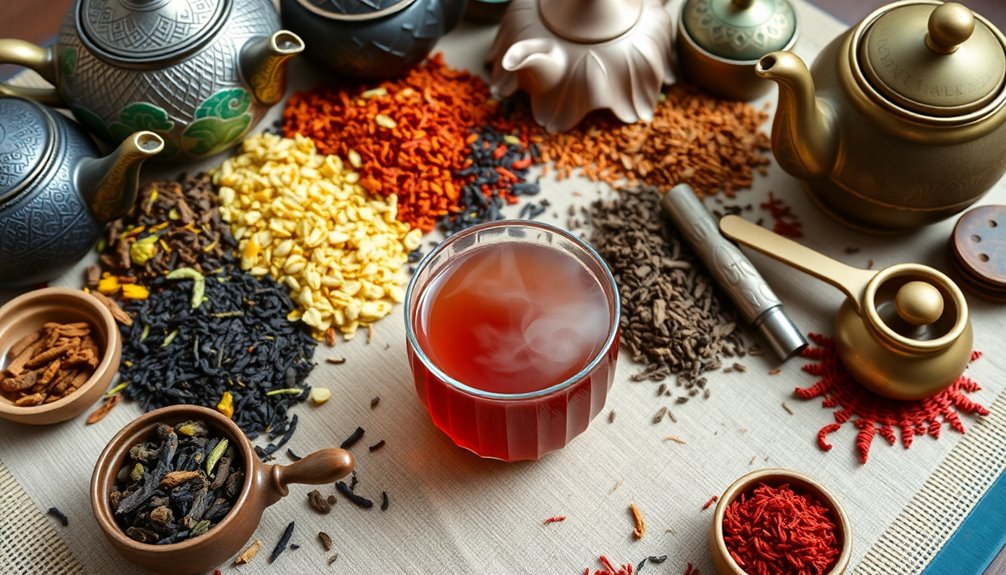
Blending tea goes beyond mere flavors; it's a vibrant tapestry woven into the fabric of many cultures. When you dive into creating a tea blend, you're not just mixing ingredients; you're joining a global tradition.
- Cultural Significance: Many tea blends, like Indian Chai or Moroccan Mint Tea, reflect local customs and traditions.
- Social Activity: Sharing tea is a way to bring people together during celebrations or casual gatherings, building community bonds.
- Symbol of Status: Some blends, like Earl Grey, have historical ties to aristocratic families, showing how tea can signify status and heritage.
- Culinary Art: Blending black tea with herbs, spices, and fruits is an expression of cultural identity, showcasing diverse regional variations.
- Rituals: The Japanese tea ceremony highlights the mindfulness involved in the tea blending process, emphasizing harmony and respect.
Ethical Sourcing of Tea Ingredients
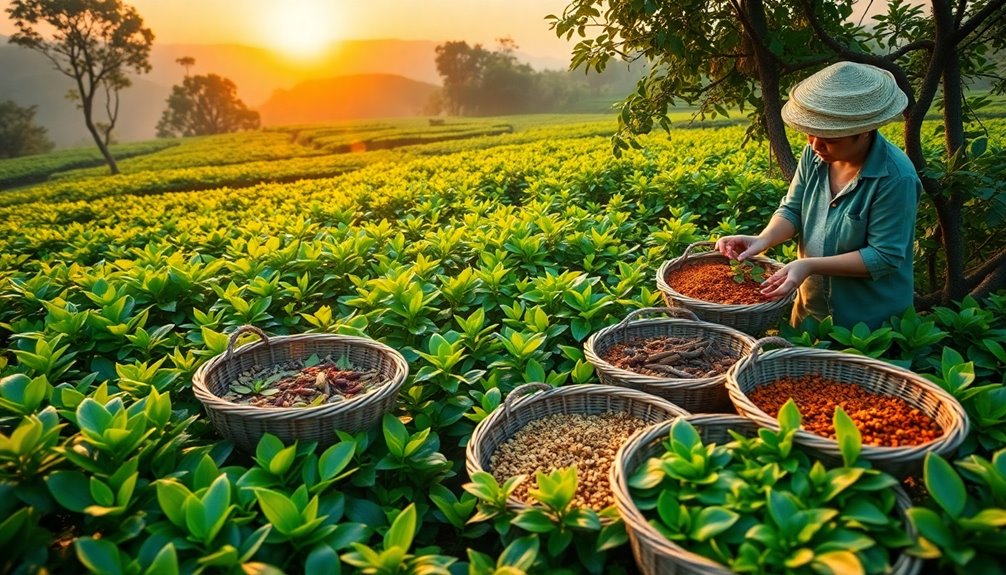
Sourcing tea ingredients ethically not only supports farmers but also enriches your tea experience. When you choose tea that's ethically sourced, you're helping small-holder farmers earn fair wages and work in safe conditions. This means they can provide for their families while preserving traditional farming practices that are good for our planet!
Opting for organic and sustainably sourced ingredients helps protect the environment. It reduces harmful chemicals that can hurt our ecosystems, making every sip feel even better. Look for certifications like Fair Trade and Rainforest Alliance. These labels show that your tea meets specific environmental and social standards, giving you peace of mind.
Transparency in the supply chain is also super important. It allows you to trace where your tea comes from, fostering trust in your purchasing decisions.
You can feel proud knowing that your choices support local communities and promote sustainable agriculture.
Practical Applications
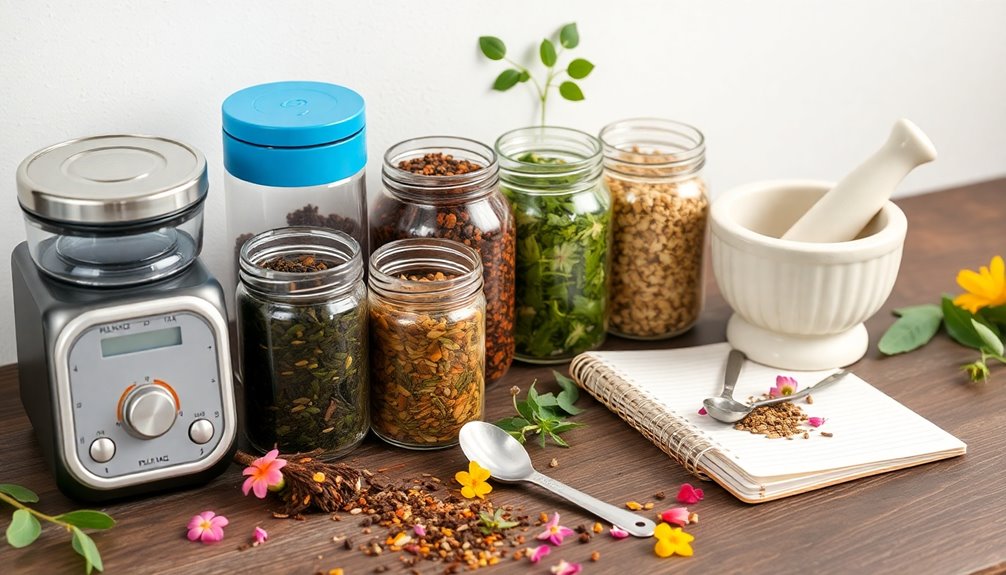
Mastering the art of tea blending opens up a world of flavors and aromas, allowing you to create unique brews tailored to your taste. Start by exploring different teas, like black teas, and various herbs. Understanding how these ingredients work together is key!
Here are some practical tips to help you blend like a pro:
- Measure Carefully: Use measuring spoons for precise proportions, beginning with 3 parts base tea, 1-2 parts supporting herbs, and 1/4-1 part accent flavors. This balance keeps your blends delightful. Additionally, consider how coffee roast levels can influence the flavor profile of your blends. Incorporating flower teas like Hibiscus Tea can add vibrant color and health benefits to your creations.
- Experiment Wisely: Try small batches to minimize waste. It's like a fun science project! Document your recipes and ratios; this way, you can refine your skills over time.
- Store Smartly: Keep your blends in airtight containers to maintain their freshness and flavor, ensuring every sip is as good as the first.
- Connect with Others: Join online tea communities for inspiration and advice. You'll discover exciting recipes that add joy to your blending journey!
Additionally, be aware that the organic tea market is projected to grow, which may inspire you to incorporate sustainable practices into your blending. With these tips, you'll create delicious teas that can even serve as herbal medicine for family and friends. Happy blending!
Frequently Asked Questions
What Is the Tea Blending Process?
The tea blending process involves combining various ingredients like tea types, herbs, and spices. You'll need to focus on balance, selecting ideal pairings, and documenting your ratios to create unique and flavorful blends.
What Tools Do You Need to Make Tea?
To make tea, you'll need measuring spoons and cups for precision, airtight containers for storage, a tea infuser for brewing, a digital scale for accuracy, and a temperature-controlled kettle for optimal flavor extraction.
Can I Make My Own Tea Blend?
Yes, you can definitely create your own tea blend! Start with three favorite herbs, experiment with proportions, and document your combinations. Engaging with tea communities will inspire your blending journey and help refine your taste.
What Is the Ratio for Tea Blending?
When blending tea, you should aim for a ratio of 3 parts base tea to 1-2 parts supporting ingredients and 1/4-1 part accent ingredients. This balance creates a harmonious flavor profile for your blend.
Conclusion
Now that you've got the tools to blend your own tea, it's time to get creative! Mix different herbs, play with ratios, and discover flavors that make your taste buds dance. Remember, tea blending is not just about taste; it's a fun way to share culture and connect with others. So, gather your family, sip together, and enjoy the process. With a little practice, you'll be a tea blending pro in no time! Happy blending!

